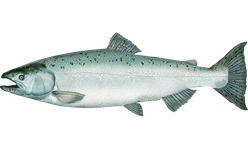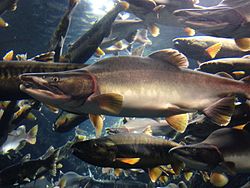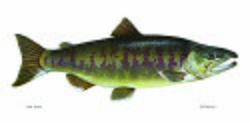An extensive list of the freshwater fish found in California, including both native and introduced species. [1]
| Common name | Scientific name | Image | Native | Non-Native | Notes |
|---|---|---|---|---|---|
| Pacific Lamprey | Lampetra tridentata |  | |||
| River Lamprey | Lampetra ayresl |  | |||
| Pit-Klamath Brook Lamprey | Lampetra lethophaga | ||||
| Klamath River Lamprey | Lampetra simiiis | ||||
| Kern Brook Lamprey | Lampetra hubbsi | ||||
| Western Brook Lamprey | Lampetra ricchardsoni |  | |||
| White Sturgeon | Acipenser transmontanus |  | |||
| Green Sturgeon | Acipenser medirostris |  | |||
| American Shad | Alosa sapidissima |  | |||
| Threadfin Shad | Dorosoma petenense |  | |||
| Coho Salmon or Silver Salmon | Oncorhynchus kisutch |  | |||
| Chinook Salmon or King Salmon | Oncorhynchus tshawytscha |  | |||
| Kokanee Salmon or Sockeye Salmon | Oncorhynchus nerka |  | |||
| Pink Salmon | Oncorhynchus gorbuscha |  | |||
| Chum Salmon | Oncorhynchus keta |  | |||
| Rainbow Trout | Oncorhynchus mykiss |  | |||
| Coastal Rainbow Trout or Steelhead Trout | Oncorhyncus mykiss irideus | ||||
| California Golden Trout | Oncorhynchus mykiss aguabonita | ||||
| Little Kern Golden Trout | Oncorhynchus mykiss whitel | ||||
| Kern River Rainbow Trout | Oncorhynchus mykiss gilberti | ||||
| Sacramento Redband Trout | Oncorhynchus mykiss stonei | ||||
| Eagle Lake Rainbow Trout | Oncorhynchus mykiss aquilarum | ||||
| Cutthroat Trout | Oncorhynchus clarkii | ||||
| Coastal Cutthroat Trout | Oncorhynchus clarkii clarkii | ||||
| Lahontan Cutthroat Trout | Oncorhynchus clarkii henshawl | ||||
| Paiute Cutthroat Trout | Oncorhynchus clarkii seleniris | ||||
| Bull Trout | Salvelinus confluentus | ||||
| Brook Trout | Salvelinus fontinalls | ||||
| Brown Trout | Salmo trutta | ||||
| Lake Trout or Mackinaw Trout | Salvelinus namaycush | ||||
| Mountain Whitefish | Prosoplum williamsoni | ||||
| Delta Smelt | Hypomesus transpacificus | ||||
| Wakasagi | Hypomesus nipponensis | ||||
| Longfin Smelt | Spirinchus thalechthys | ||||
| Eulachon | Thaleichthys pacificus | ||||
| California Roach | Lavinia symmetricus | ||||
| Hitch | Lavinia exilicauda | ||||
| Lahontan Redside | Richarsonius egregius | ||||
| Speckled Dace | Rhinichthys osculus | ||||
| Tui Chub | Siphateles bicolor | ||||
| Mojave Tui Chub | Siphateles bicolor mohavensis | ||||
| Owens Tui Chub | Siphateles bicolor snyderi | ||||
| Blue Chub | Gila coerulea | ||||
| Arroyo Chub | Gila orcutti | ||||
| Thicktail Chub | Gila crassicauda | ||||
| Bonytail | Gila elegans | ||||
| Sacramento Splittail | Pogonichthys macrolepidotus | ||||
| Clear Lake Splittail | Pogonichthys ciscoldes | ||||
| Hardhead | Mylopharodon conocephalus | ||||
| Sacramento Blackfish | Orthodon microlepidotus | ||||
| Sacramento Pikeminnow | Ptychochellus grandis | ||||
| Colorado Pikeminnow | Ptychochellus luclus | ||||
| Common Carp | Cyprinus carpio | ||||
| Goldfish | Carassius auratus | ||||
| Golden Shiner | Notemigonus crysoleucas | ||||
| Red Shiner | Cyprinella lutrensis | ||||
| Fathead Minnow | Pimephales promelas | ||||
| Tench | Tinca tinca | ||||
| Grass Carp | Ctenopharyngodon idella | ||||
| Sacramento Sucker | Catostomus occidentalls | ||||
| Goose Lake Sucker | Catostomus occidentalis lacusanserinus | ||||
| Tahoe Sucker | Catostomus tahoensis | ||||
| Owens Sucker | Catostomus fumelventris | ||||
| Lost River Sucker | Catostomus luxatus | ||||
| Klamath Largescale Sucker | Catostomus snyderi | ||||
| Klamath Smallscale Sucker | Catostomus rimiculus | ||||
| Modoc Sucker | Catostomus microps | ||||
| Santa Ana Sucker | Catostomus santaanae | ||||
| Razorback Sucker | Xyrauchen texanus | ||||
| Shortnose Sucker | Chasmistes brevirostris | ||||
| Brown Bullhead | Amelurus nebulosus | ||||
| Mountain Sucker | Catostomus platyrhynchus | ||||
| Black Bullhead | Amelurus melas | ||||
| Yellow Bullhead | Amelurus natalls | ||||
| Channel Catfish | Ictalurus puctatus | ||||
| Blue Catfish | Ictalurus furcatus | ||||
| White Catfish | Ameriurus catus | ||||
| Flathead Catfish | Plyodictis olivaris | ||||
| Amargosa Pupfish | Cyprinodon nevadensis | ||||
| Desert Pupfish | Cyprinodon macularius | ||||
| Salt Creek Pupfish | Cyprinodon salinus | ||||
| Owens Pupfish | Cyprinodon radiosus | ||||
| California Killifish | Fundulus parvipinnis | ||||
| Rainwater Killifish | Lucania parva | ||||
| Western Mosquitofish | Gambusia affinis | ||||
| Sailfin Molly | Poecilla latipinna | ||||
| Porthole Livebearer | Poecillopsis gracilis | ||||
| Inland Silverside | Menidia beryllina | ||||
| Threespine Stickleback | Gasterosteus aculeatus | ||||
| Brook Stickleback | Culaea inconstans | ||||
| Striped Bass | Morone saxatilis | ||||
| White Bass | Morone chrysops | ||||
| Sacramento Perch | Archoplites interruptus | ||||
| Bluegill | Lepomis macrochirus | ||||
| Redear Sunfish | Lepomis microlophus | ||||
| Pumpkinseed | Lepomis gibbosus | ||||
| Green Sunfish | Lepomis cyanellus | ||||
| Warmouth | Lepomis gulosus | ||||
| White Crappie | Pomoxis annularis | ||||
| Black Crappie | Pomoxis nigromaculatus | ||||
| Largemouth Bass | Micropterus salmoides | ||||
| Smallmouth Bass | Micropterus dolomieu | ||||
| Spotted Bass | Micropterus punctulatus | ||||
| Redeye Bass | Micropterus coosae | ||||
| Yellow Perch | Perca flavescens | ||||
| Bigscale Logperch | Percina macrolepida | ||||
| Mozambique Tilapia | Oreochromis mossambicus | ||||
| Redbelly Tilapia | Tilapia zillii | ||||
| Blue Tilapia | Oreochromis aureus | ||||
| Nile Tilapia | Oreochromis niloticus | ||||
| Tuleperch | Hysterocarpus traski | ||||
| Shiner Perch | Cymatogaster aggregata | ||||
| Striped Mullet | Mugil cephalus | ||||
| Yellowfin Goby | Acanthogoblus flavimanus | ||||
| Shimofuri Goby | Tridentiger bifasclatus | ||||
| Tidewater Goby | Eucyclogoblus newberryi | ||||
| Prickly Sculpin | Cottus asper | ||||
| Riffle Sculpin | Cottus gulosus | ||||
| Pit Sculpin | Cottus pitensis | ||||
| Coastrange Sculpin | Cottus aleuticus | ||||
| Reticulate Sculpin | Cottus perplexus | ||||
| Marbled Sculpin | Cottus klamathensis | ||||
| Rough Sculpin | Cottus asperrimus | ||||
| Paiute Sculpin | Cottus beldingi | ||||
| Pacific Staghorn Sculpin | Leptocottus armatus | ||||
| Starry Flounder | Platichthys stellatus | ||||
| Northern Pike | Esox lucius | ||||